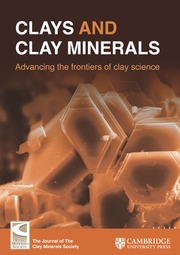No CrossRef data available.
Article contents
The role of illite in the global cycle of elements
Published online by Cambridge University Press: 08 August 2025
Abstract
This review paper presents in more detail the key points of the Brindley Award lecture given at the 61st Annual Meeting of The Clay Minerals Society and 5th Asian Clay Conference in Honolulu in June 2024. It is focused on the research of the author, even though it credits earlier findings. The paper discusses first the definition of illite, its position in mineral classification, the distinction between illite and true micas, the illite crystal-growth mechanism, and the specific properties of illite, resulting from its small crystal size. Second, this review presents evidence and explanation for the exceptional abundance of this mineral on Earth’s surface. Third, the behavior of illite in the rock cycle is characterized: in weathering, in sedimentation, and in diagenetic, metamorphic, and hydrothermal environments. Finally, the exceptional role of illite in geochemical cycling of water and elements K, N, B, Rb, and Cs is presented.
Information
- Type
- Original Paper
- Information
- Copyright
- © The Author(s), 2025. Published by Cambridge University Press on behalf of The Clay Minerals Society


